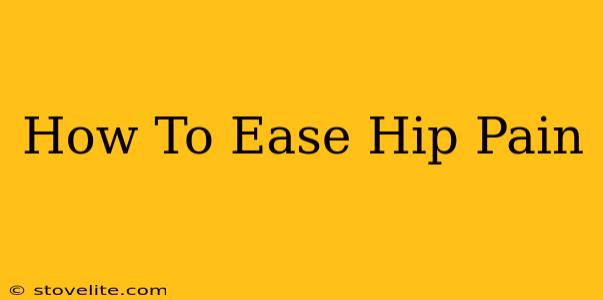Hip pain can significantly impact your daily life, making even simple tasks feel challenging. Understanding the causes and implementing effective strategies for pain management is crucial for regaining mobility and improving your overall well-being. This comprehensive guide explores various methods to ease hip pain, from simple at-home exercises to professional medical interventions.
Understanding Hip Pain: Identifying the Root Cause
Before diving into solutions, it's vital to understand what is causing your hip pain. Several factors can contribute, including:
- Osteoarthritis: This degenerative joint disease is a common cause of hip pain, characterized by the breakdown of cartilage.
- Bursitis: Inflammation of the bursae (fluid-filled sacs cushioning the hip joint) can cause sharp, localized pain.
- Tendinitis: Inflammation of the tendons surrounding the hip joint can lead to pain and stiffness.
- Muscle strains or tears: Overexertion or injury can strain or tear the muscles surrounding the hip.
- Labral tears: Tears in the cartilage ring (labrum) that surrounds the hip socket can cause pain and instability.
- Referred pain: Pain originating from other areas, such as the lower back or spine, can sometimes be felt in the hip.
It's crucial to consult a doctor or physical therapist for an accurate diagnosis. Self-treating can sometimes worsen the condition. A proper diagnosis will guide you toward the most effective treatment plan.
Easing Hip Pain: Effective Strategies
Once you have a diagnosis, you can begin implementing strategies to ease your hip pain. Here are some effective methods:
1. Gentle Exercise and Stretching
Regular, low-impact exercise is vital for strengthening the muscles supporting your hip joint and improving flexibility. Exercises like:
- Walking: A great low-impact option for improving mobility and strengthening leg muscles.
- Swimming: The buoyancy of water reduces stress on the hip joint, allowing for gentle exercise.
- Cycling: Another low-impact option that strengthens leg muscles without excessive strain on the hip.
- Yoga and Pilates: These practices improve flexibility, strength, and balance, all beneficial for hip health.
Important Note: Start slowly and gradually increase the intensity and duration of your workouts. Listen to your body and stop if you experience any sharp pain.
2. Heat and Ice Therapy
Applying heat or ice can provide temporary relief from hip pain:
- Heat: Helps relax muscles and improve blood flow, reducing stiffness and pain. Use a heating pad or warm compress for 15-20 minutes at a time.
- Ice: Reduces inflammation and numbs pain. Apply an ice pack wrapped in a towel for 15-20 minutes at a time.
Experiment to see which method works best for you. You might find alternating heat and ice provides the most relief.
3. Over-the-Counter Pain Relief
Over-the-counter medications like ibuprofen (Advil, Motrin) or naproxen (Aleve) can help reduce pain and inflammation. Always follow the dosage instructions on the label.
4. Physical Therapy
A physical therapist can design a personalized exercise program to strengthen your hip muscles, improve flexibility, and improve your overall hip function. They can also teach you proper body mechanics to reduce strain on your hip joint.
5. Lifestyle Modifications
Certain lifestyle changes can significantly impact hip pain:
- Maintaining a healthy weight: Excess weight puts extra stress on your hip joints, exacerbating pain.
- Ergonomic improvements: Ensure your work setup and daily activities are ergonomically sound to minimize strain on your hips.
- Proper posture: Maintain good posture to reduce strain on your spine and hips.
When to Seek Professional Medical Attention
While many strategies can ease hip pain, some situations require professional medical attention:
- Severe or persistent pain: If your hip pain is intense, doesn't respond to home remedies, or worsens over time, seek medical advice.
- Sudden onset of hip pain: Sudden, severe hip pain, especially after an injury, requires immediate medical attention.
- Limping or difficulty walking: Significant changes in your gait or ability to walk indicate a potential serious problem.
- Hip stiffness or locking: Inability to move your hip normally requires medical evaluation.
Your hip health is crucial for your overall well-being. By understanding the causes of hip pain and implementing appropriate strategies, you can regain mobility, reduce pain, and improve your quality of life. Remember to always consult with a healthcare professional for diagnosis and treatment recommendations.

